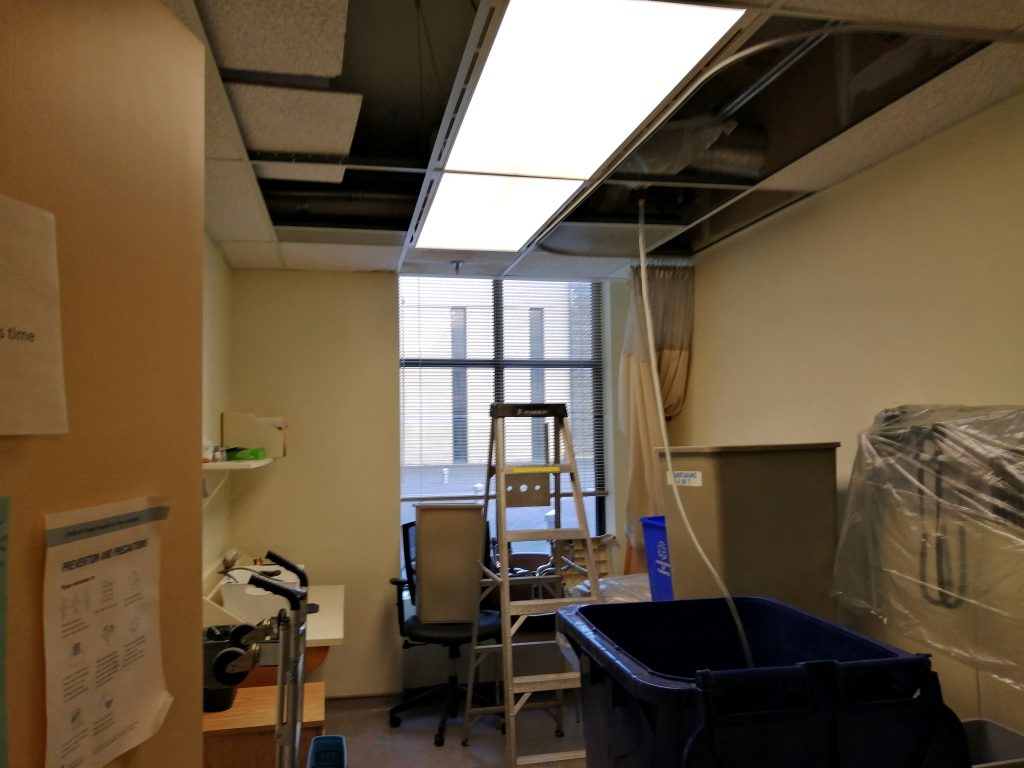
STEP 1: REPORT THE WATER EVENT
For building-related water events (e.g., leaks from roof, plumbing or HVAC equipment, floods, fallen ceiling tiles, sprinkler burst), report it to your supervisor/academic contact and local facilities teams:
-
- St. George Campus, Facilities and Services (F&S), call 416-978-3000
- UTSC Facilities Management, call 416-287-7579
- UTM Facilities Management & Planning, call 905-828-5200
STEP 2: WATER RESPONSE, REMEDIATION, AND RESTORATION
Work with facilities and follow their instructions. Facilities (e.g., property manager) will manage critical events associated with building water intrusions and floods. They will coordinate with other facilities staff or contractors to respond, investigate, isolate, clean-up the flood water, and assist with drying and restoration. An EHS assessment is not required, however, facilities or occupants can contact EHS for assistance if there are concerns and/or visible signs of mould growth, odours or health concerns following a water event.
Facilities will be responsible for removing the water as soon as possible (within 24–48hrs), discarding any non-salvageable porous materials and drying impacted building materials rapidly (carpets, walls, cavities, etc.) to prevent mould growth, per the Mould Control Program (see EHS Mould Webpage for more information). This may involve moving furniture/items to allow access to walls and carpets to dry. The strategic placement of fans and dehumidifiers within a space to assist with drying will also be managed by facilities.
Floods Involving Asbestos Sprayed-on Fireproofing
- In buildings with asbestos sprayed-on fireproofing on the St. George Campus, F&S will assess, identify, and coordinate applicable asbestos flood clean-up per the Asbestos Management Program.
- Building occupants should follow any signage or direction provided by facilities staff.
- Occupants should not dust, sweep or vacuum any debris or water until it has been assessed by F&S/Hazardous Construction Materials Group/EHS.
- Notify your supervisor if you are uncertain if your area has been assessed for asbestos or if you have further concerns.
- The level of clean-up required will depend on the level and impact of each flood, determined on a case-by-case basis by facilities. Normal activities can resume when the clean-up and/or restoration has been completed.
STEP 3: SORT AND DRY AFFECTED PERSONAL AND DEPARTMENT ITEMS
Sort and dry out personal belongings and department items when safe to do so. Once the area has been assessed by facilities and initial clean-up of flood water is complete, all other remaining porous items belonging to building occupants and departments that were impacted will require drying or be discarded immediately to prevent mould growth.
- Confirm with your supervisor that clean-up is completed and re-entry is permitted (supervisors should confirm with their facilities contact).
- Occupants are responsible for sorting and drying any personal belongings that may have been wet (e.g., shoes, bags, coats, pamphlets, binders, files and boxes, etc.) as soon as possible after a flood event, see tips below. Additional instructions or assistance may be provided by facilities.
TIPS FOR SORTING & DRYING WET PERSONAL AND/OR DEPARTMENT BELONGINGS OR ITEMS
- Visually inspect all items including the bottom of cabinets, on the inside of boxes or bins on shelves and furniture, or any items placed on the floor that may have been wetted.
- Lift personal items off any wet carpets (e.g., shoes, boxes, chair mats, small area carpets, etc.). Immediately lay out items on a flat dry surface to allow for drying; do not stack. Contact facilities if you require fans, dehumidifiers, or movers to assist.
- Discard anything that is no longer needed; this is an opportunity to organize and purge any old documents or any unwanted items. Contact facilities to request additional bins, dollies or containers if needed. Set aside any books or papers that may require professional conservation treatment (e.g., artwork, rare books, etc.).
- Continue to regularly inspect any items; move and rotate them where needed to help dry. If you see or smell (e.g., musty, earthy) any signs of suspect mould development on these items, carefully isolate in a corner or in a bag where possible and/or contact facilities to assist.
- If you have any colleagues or team members who are on vacation or working remotely, their items will also need to be sorted. Contact your supervisor/academic contact to help coordinate.
- If you observe any outlets, electrical equipment or light fixtures that may have been impacted with water, contact your facilities to review and determine next steps where applicable.
TIPS TO PREVENT FLOODS / WATER LEAKS
- Do not leave any sinks or water sources turned on and unattended. Always turn off the tap when leaving an area.
- Do not prop exterior windows and doors open unattended. In winter months, water inside pipes, radiators and sprinklers can freeze if exposed to cold temperatures and burst, leading to leaks or floods.
- Periodically check areas underneath sinks and appliances (e.g., laundry machines), near exterior walls, or on the ceiling. If there are signs of water leak / intrusion, contact facilities to investigate.